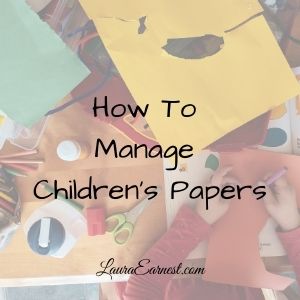
How To Manage Children’s Papers
Childhood is precious, and it passes quickly. The souvenirs of childhood – the papers that mark the gain of skills – can become a jumbled mass if not handled well. Without the context of child, age and year, many of the milestones can disappear. Today we will talk about a method to manage children’s papers.
Children are rightfully proud of the work they create, and they want to share it with their families. The amount of paper, though, can be overwhelming, with art projects, spelling tests,worksheets and more. If you have more than one child, it can take over. With a simple system, you can manage the paper so you don’t lose the context of who did what when, but also not be overwhelmed with the quantity.
Oh, the Paper!
My daughter’s projects started coming home when she was two. We were lucky that we had a wonderful care center for her, and one of the things they worked on was fine motor skills.That meant lots of drawing, gluing, glitter (sigh), stamping, and other forms of flat-surface art. As she aged, they added vocabulary, reading and spelling, and when she reached primary school there were worksheets, math tests and music exercises. At the peak production, we would go through her school folders and pull out dozens of sheets. After a month, I felt like I was drowning in paper. At the same time, her grandparents, both sets half a country away, never got to see these important milestones.
Keeping In Under Control
If you don’t deal with it in a timely manner, you can forget when (and who) made each piece. There is hope, though. With a few simple strategies, you can manage the paper without drowning in it.
Collect It In One Spot
As the paper comes in, you need to sort it. Have one basket for each child, and put the papers in there after going over them with your child. Don’t worry about the “what do we keep” at this moment.
Having a central place to keep all the papers for a week means you only have to deal with the stack once a week, and you will never have to remember whose papers belong to whom.
Process Once A Week
Once a week, you will need to go through each basket. This prevents the buildup, but also allows you to mark the papers.
A simple custom self-inking stamp* for each child will allow you to set the date, and quickly label everything on the back quickly.
I found it easiest to use the date stamp rather than writing because it was faster to process with a stamp than writing on the back of each piece. Adding the name to the stamp means you can also keep each child’s papers separate (because they will get mixed up).
Artist’s Pick
The amount of paper can be great. Asking your child to pick one piece to keep will allow them to narrow it down.
I would ask my daughter which piece she wanted on the fridge for that week. I also asked her why, because often her choices were not the ones I would have picked. This allowed me to hear more about her school work. She could tell me that the spelling test with three wrong was more important than the 100 on a worksheet because she had trouble remembering how to spell a word, and she finally got it.
Share the Bounty
The rest of the papers would be divided up and sent to the grandparents. That way they got to see what my daughter was doing, and most importantly allowed me to get it out of the house. My mother got great enjoyment of having drawings on her fridge.
Move to Storage
Once you have put the week’s paper up in the spot of honor, you will need to take care of last week’s selection. I am a big fan of one-box filing, so I had a single box that I would drop the old paper in.
When it came time to make a scrapbook, I pulled out the box, and by seeing what was on the back, I was able to quickly put the pages in chronological order.
By labeling the papers as they come in, you preserve the context of who and when the papers were from. By having the child select one and sending the rest to relatives, you keep the amount of papers at a minimum as well as share these precious relics of childhood.
I have found that this system of handling children’s papers works well with the Getting Household Things Done system. Keeping the inbox near where the children keep their school bags and processing once a week fits right in with the regular system.




